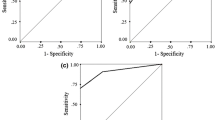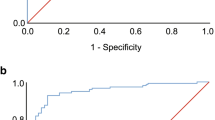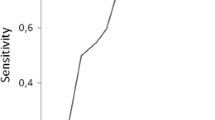Abstract
Polysomnography is currently considered as the gold standard for the diagnosis of obstructive sleep apnea syndrome (OSAS). But high expense and the backlog of the sleep centers have resulted in a search for an alternative method of diagnosis. The aim of this study is to assess the efficacy and reliability of Watch PAT as an alternate option in OSAS diagnosis. The patients have worn a Watch PAT® 200 device in the sleep laboratory during a standard polysomnography. The correlation in REM and Non-REM AHI scores, sleep periods and the mean O2 saturation percentage between Watch PAT and PSG sleep studies were assessed. There was a statistically significant very strong correlation between PSG and Watch PAT AHI scores (Spearman’s rho = 0.802 p < 0.001). The mean recording time with PSG and Watch PAT was 463.06 ± 37.08 and 469.33 ± 72.81 min, respectively, and there was no statistically significant difference (p = 0.068). However, there was a statistically significant difference between two methods regarding the average sleep time and REM sleep period. No statistically significant difference was revealed in the mean O2 saturation percentage (p < 0.001). Watch PAT is an efficient device and is considered to be an adjunctive diagnostic method for PSG in diagnosis of OSAS.


Similar content being viewed by others
References
Young T, Palta M, Dempsey J, Skatrud J, Weber S, Badr S (1993) The occurrence of sleep disordered breathing among middle-aged adults. N Engl J Med 328(17):1230–1235
Bennett JA, Kinnear WJ (1999) Sleep on the cheap: the role of overnight oximetry in the diagnosis of sleep apnoea hypopnoea syndrome. Thorax 54(11):958–959
Young T, Evans L, Finn L, Palta M (1997) Estimation of the clinically diagnosed proportion of sleep apnea syndrome in middle aged men and women. Sleep 20(9):705–706
American Academy of Sleep Medicine (1999) Sleep-related breathing disorders in adults: recommendations for syndrome definition and measurements techniques in clinical research; the report of an American Academy of Sleep Medicine Task Force. Sleep 22(5):667–689
Pang KP, Gourin CG, Terris DJ (2007) A comparison of polysomnography and the WatchPAT in the diagnosis of obstructive sleep apnea. Otolaryngol Head Neck Surg 137(4):665–668
Grote LB, Hedner J, Ding Z (2001) Alteration of digital pulse amplitude reflects alpha adrenoceptor mediated constriction of the digital vascular bed. Sleep 24(Suppl):A79
Bar A, Pillar G, Dvir I, Sheffy J, Schnall RP, Lavie P (2003) Evaluation of a portable device based on peripheral arterial tone for unattended home sleep studies. Chest 123(3):695–703
Ayas NT, Pittman S, MacDonald M, White DP (2003) Assessment of a wrist-worn device in the detection of OSA. Sleep Med 4(5):435–442
Cirignotta F, Mondini S, Geradi R, Mostacci B, Sancisi E (2001) Unreliability of automatic scoring of MESAM 4 in assessing patients with complicated obstructive sleep apnea syndrome. Chest 119(5):1387–1392
O’Donnell CP, Allan L, Atkinson P, Schwartz AR (2002) The effect of upper airway obstruction and arousal on peripheral arterial tonometry in obstructive sleep apnea. Am J Respir Crit Care Med 166(7):965–971
Pitson DJ, Stradling JR (1998) Autonomic markers of arousal during sleep in patients undergoing investigation for obstructive sleep apnea, their relationship to EEG arousals, respiratory events and subjective sleepiness. J Sleep Res 7(1):53–59
Schnall RP, Slitner A, Sheffy J, Kedar R, Lavie P (1999) Periodic, profound peripheral vasoconstriction: a new marker of obstructive sleep apnea. Sleep 22(7):939–946
Young T, Peppard PE, Gottlieb DJ (2002) Epidemiology of obstructive sleep apnea: a population health perspective. Am J Respir Crit Care Med 165(9):1217–1239
Valipour A (2012) Gender-related differences in the obstructive sleep apnea syndrome. Pneumologie 66(10):584–588
Hedner J, White DP, Malhotra A, Herscovici S, Pittman SD, Zou D et al (2011) Sleep staging based on autonomic signals: a multi-center validation study. J Clin Sleep Med 7(3):301–306
Lavie P, Schnall RP, Sheffy J, Shlitner A (2000) Peripheral vasoconstriction during REM sleep detected by a new plethysmographic method. Nat Med 6(6):606
Ceylan T, Fırat H, Kuran G, Ardıç S, Bilgin E, Celenk F (2012) Quick diagnosis in obstructive sleep apnea syndrome: watchPAT-200. Iran Red Crescent Med J 14(8):475–478
Lewendowski DJ, Zack N, Rao S, Wong K, Gendreau M, Kranzler J et al (2009) Assessment of the test-retest reliability of laboratory polysomnography. Sleep Breath 13(2):163–167
Acknowledgements
We thank Dr. F. Nur Aksakal from Gazi University Public Health Department for her assistance in statistical analysis. This study was supported by Gazi University Scientific Research Projects Department with the code number 01/2009–31.
Conflict of interest
There is no conflict of interest within the authors of this study.
Author information
Authors and Affiliations
Corresponding author
Rights and permissions
About this article
Cite this article
Körkuyu, E., Düzlü, M., Karamert, R. et al. The efficacy of Watch PAT in obstructive sleep apnea syndrome diagnosis. Eur Arch Otorhinolaryngol 272, 111–116 (2015). https://doi.org/10.1007/s00405-014-3097-0
Received:
Accepted:
Published:
Issue Date:
DOI: https://doi.org/10.1007/s00405-014-3097-0




